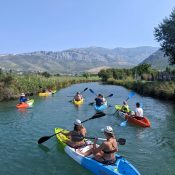Choosing A Stand Up Paddle Board

Choosing A Stand Up Paddle Board
Choosing A Stand Up Paddle Board
With so many different options out there, it may feel overwhelming when you finally decide to take the proverbial plunge and purchase a stand up paddle board. There are a few different types of boards, with different characteristics and uses. They exist on the market for every type of paddler – whether you’re just starting out or looking for a little more action.
Hull Type
Most boards have either a planing or displacement hull, although there are even combination hybrids of the two types. A planing hull is flat, wide, and designed to float on top of the water with lots of maneuverability. Generally these boards are used for leisure rowing, Yoga, or Surfing. A board with a displacement hull will have a pointed nose like a kayak. This makes the board cut through the water with higher efficiency. This hull equates to faster speeds but less maneuverability which makes them ideal for more aggressive fitness paddling, racing, and touring.
Solid or Inflatable?

They also come in a variety of material constructions, sizes, and shapes. You have more room for customization and finding a board that perfectly fits your body and needs. The only major downside is you need a place to store them when not in use, and travelling with them can be a hassle.
So what can an inflatable board offer you?
Since they zip up and compress into such tiny bags, they can go virtually anywhere. This means they’re great for air travel or remote hiking, and don’t require the storage space of a solid board. Lastly, inflatable boards are better suited for whitewater paddling. Their construction is better suited for bumping against jagged rocks and waters. Since they’re also slightly softer than a solid board, some people prefer them for SUP yoga practice.
Board Length
The length of the board is a huge factor in how the board will perform, and what activities you want to use it for.
Board length is important in how you’ll store the board, how far you’ll be transporting it to the water, and how the board will perform in the water. Longer boards are faster, but shorter boards are more maneuverable in the water.
Boards under 10 feet are generally meant for children and surfing; their tiny length makes them super nimble in the water. Due to their small size though, they generally don’t track in a straight line on flat water.
Medium boards – boards between 8 and 10 feet – are all around boards that are great for casual rowing and Yoga.
Boards over 12 feet are designed to cut through the water with speed, and are great for touring, racing, and covering large distances quickly.
Flat water boards have a more pointed nose and are designed to cut through water at greater speeds, but with less control, while an all – round board will be more rounded and designed for general use.
Board Width
The width of your paddle board will also determine how the board performs and how you feel standing on it.
Boards generally have widths from 25 to 36 inches and choosing a size depends on your body, ability level, and desired activity.
Generally the wider the board, the more stable, but less maneuverable.
Boards that are over 31 inches wide are great for SUP Yoga because they’re stable and have plenty of space. They’re also ideal for people transporting coolers, tents and more. If you are a large person, you’ll want a wide board so you feel more stable and supported in the water. However, small people should use narrow boards so that they’re supported but also can reach the water comfortably with their paddles. A heavier person on a small board will be very unbalanced, and a skinny person on a large board will have trouble maneuvering the board and paddling.
Board Thickness/Depth
Stand up paddle boards also have varying thicknesses in their construction. Generally speaking, thicker boards are able to support more weight and add more stability than a thinner board. If you’re trying to maximize speed though, a thinner board is more suitable for you.
Board Construction 
Hardtop SUP’s can be constructed from different types of materials such as foam, fiberglass, wood, plastic, kevlar, and more. The most standard construction you’ll find is an epoxy fiberglass board with a foam core (EPS). These boards have great glide and performance while being light and agile. Fiberglass is less durable and harder to transport and store though.
Soft top boards are similar to epoxy boards but have a soft, spongy top that is slip resistant and softer for falls. These are great for families and dogs, but are also heavier and limited in options usually.
Plastic SUP’s are an affordable option that are extremely durable and great for camping, but are often heavier and more cumbersome.
So before purchasing your next stand up paddle board, remember to ensure you’re choosing all the appropriate options for your paddling needs, body type, water conditions, and budget. If your board doesn’t fit your body and needs, you’re more liable to injure yourself or have a difficult time. Try to rent your first paddle board to try them out, check out this magazine for better reference.

The ultimate guide for paddle board renting all around the world!
So do your research, pick your board, and get out there and enjoy the water!

Adriatic SUP Split
All Categories
Recent Posts
The Cold History of Kayaking: From Inuit to Today
7-Type of Flatwater Kayaks
How to use iSup






